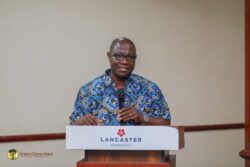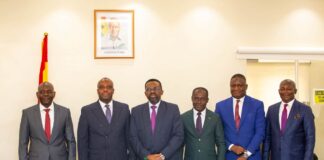- as its rehabilitation efforts bear fruit
- US$6.8 mn invested, over 900ha successfully reclaimed
Mining, if responsibly done is not antithetical to agriculture but rather complementary, and the efforts of Gold Fields (Ghana) Limited are verifiable proof of this, a senior environmental officer at the mining behemoth, Desmond Asare, has said.
Ghana’s status as the leading gold-producing country in Africa has resulted in significant consequences, primarily manifesting as land degradation and water pollution. These issues directly impact agriculture, as indicated by a 2017 analysis from the International Growth Centre (IGC).
According to their findings in the Western Region, the cost of reclaiming lands and water bodies damaged by illegal mining, specifically galamsey, is estimated to be around US$250 million.
Mr. Asare stated that Gold Fields, acutely aware of this, has implemented robust environmental management practices to mitigate the negative impact of mining activities. The company has invested significantly in reclamation efforts, restoring degraded lands and water bodies. Furthermore, they have collaborated with local communities and farmers to develop sustainable agricultural practices that complement mining operations.

“Mining, if responsibly done, can coexist harmoniously with agriculture, benefiting both sectors,” said to the B&FT during the National Agricultural Fair to commemorate the 39th National Farmers Day.
This, he explained was the rationale behind the transformative land rehabilitation project hos outfit has undertaken through its Gold Fields Foundation. The initiative, he added, is not just a commitment to fulfilling environmental responsibilities but a proactive approach to leaving a positive and lasting impact on the communities they operate in.
“Gold is a finite resource, and when mining activities cease, the land must be returned to host communities. Our rehabilitation project not only fulfils this obligation but also promotes sustainable agriculture, ensuring a lasting positive impact.” Mr. Asare elaborated.
Recent data shows that over 900 hectares of land have been rehabilitated in Damang and Tarkwa combined. The investment from the Gold Fields Foundation surpasses US$6.8 million, affirming the company’s financial commitment to sustainable agricultural practices.
The foundation’s efforts extend beyond mere reclamation; they actively support a diverse range of crops, including cabbage, coconut, cashew, orange, tangerine, avocado, mango, cassava, plantains and palm oil.
“You would notice that these are cash crops and we have chosen them to ensure that the communities where we have operated are left with these viable options. The strategic selection is a result of meticulous engagement with local communities, regulatory bodies, and continuous recommendations from various stakeholders,” added Helena Akua Appiah, a Community Affairs Officer.

Additionally, Gold Fields, through its Foundation, initiated the Youth in Horticulture Production (YouHoP) program in 2016, in collaboration with the German Development Cooperation (GIZ).
The YouHoP provides comprehensive training to vegetable farmers, resulting in 60 farmers achieving Green Label Certification in 2020. This initiative has positively impacted 662 farmers and community members along the value chain. Additionally, soft loans are made available through the Promprom Credit Union.
Its Cocoa Farmers’ Support Programme, launched in 2018, focuses on boosting cocoa yields and income for Damang mine communities. Currently, 360 cocoa farmers, with 36 percent being women, benefit from the program, leading to a 33 percent increase in cocoa yields and a seven percent rise in income, as revealed in a recent assessment.
Furthermore, blast-exclusive zones and fallow lands on the mines have been transformed into rubber plantations and crop farms, offering agricultural opportunities to the host communities.
As a result, Gold Fields has become a model for responsible mining, showcasing the possibility of fostering a symbiotic relationship between mining and agriculture.
“We have established a showcase for the Minerals Commission. They frequently advise other mining companies that visit us, encouraging them to witness our successful initiatives and explore the potential for replication in their operations,” Mr. Asare noted.
Despite these commendable efforts, the company faces challenges from illegal miners and farmers. Some areas designated for rehabilitation have been subject to illegal mining activities, requiring swift intervention from Gold Fields’ security unit to deter intruders. Additionally, illegal farmers encroach on rehabilitated areas, cutting down trees, posing a real cost to the project and jeopardizing the long-term sustainability of these initiatives.
In response to these challenges, Gold Fields remains resolute in ensuring the long-term viability of the project, Mr. Asare said.
Regular soil testing is conducted to understand soil fertility, and fruits are rigorously tested for heavy metals, especially given the mining community context. The company is implementing robust measures, including ongoing engagement with regulatory bodies, to address these challenges and actively shares its experiences with other mining companies.
“Our commitment goes beyond mining; we are dedicated to fostering sustainable practices in the areas we operate. Through responsible mining and comprehensive rehabilitation initiatives, Gold Fields aims to leave a positive and lasting impact on both the environment and the communities we serve, setting a benchmark for the industry as a whole,” added Enock Akyea, an Environmental Rehabilitation Technician.










